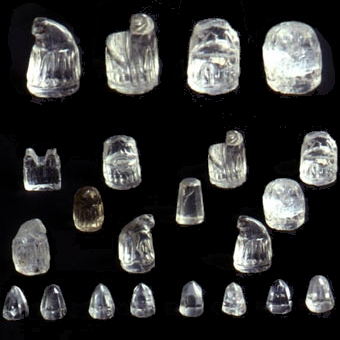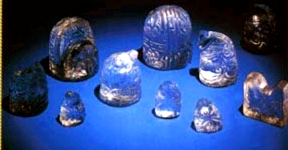The Ager Chessmen
The Ager chessmen forms one of the most wonderful medieval set and also, one of the oldest extant in Europe. Their trace is apparently found back in the will of Ersenda d'Ager wife of count Arnau Mir de Tost in 1068 or in the will of Arnau himself in 1071. Arnau was a powerful and mighty knight in Northern Spain, lord of Urgell in Catalonia, in the 11th c. He had re-conquered Ager from the Saracens.
According to regretted Prof Calvo, from the original 96 pieces of 1071, only 44 remained five centuries later. These 44 crystal chess pieces were also seen in Ager at the beginning of 19th century by Villanueva (Murray. . p. 765). 13 of the pieces must have been lost during the 19th century, and only 14 pieces remained in the parish of St. Vicent d'Ager in 1887. In 1907, these 14 chess pieces appear in a private collection and reappeared recently in a public auction. The Emir of Kuwait purchased the lot, which was plundered by Iraqi soldiers during the Gulf War. The pieces would be now back in Kuwait.
The Ager lot now in Kuwait
This lot contains the finest pieces. The material, rock crystal, points clearly to a foreign origin, because this kind of carving is considered a typical production of the Fatimid Egyptians. The abstract Islamic design reinforces the assumption that these chess sets were not produced in Urgell, but imported from a Muslim zone.
The monastery of Ager was closed in 1857, and a part of its properties went to the bishop of Lerida, included among them, 19 chess pieces fashioned in rock crystal. Until recently, the bishops kept the pieces in their private sleeping quarters. They are now conserved at the Museum de Lleida (Lerida) Dociesa i Comarcal.

This photograph is misleading as the 4 top pieces are
shown twice. Moreover, a Pawn is missing
The Ager lot in Lleida
The material is, in every case, transparent rock crystal. Only one bishop displays a smoky, darker colour. The overall design is abstract, following the well known Islamic pattern. Pawns differ slightly in shape and in size. Basically, the form is conic, the diameter of the circular base being in average some 16mm and the height, approximately 27mm . Lateral carving also differs. One of the pawns is larger than the others, and so, it would appear as though they belong to two different chess sets, unless this particular "pawn" represents a ferz or "queen". The two opposing chess parties of Islamic chess, red and black, composed the collection. Red pieces were fashioned by adding a reddish resin in the bottom and the black pieces by using another kind of smoky rock crystal.
The Ager-Paris-Kuwait- Iraq chess pieces, are much bigger and more elaborate. Although less pleasing aesthetically, the humble lot left in Lleida could be older.













